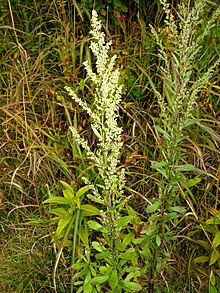Artemisia japonica
| Artemisia japonica | |
|---|---|

| |
| Scientific classification | |
| Kingdom: | Plantae |
| Clade: | Tracheophytes |
| Clade: | Angiosperms |
| Clade: | Eudicots |
| Clade: | Asterids |
| Order: | Asterales |
| Family: | Asteraceae |
| Genus: | Artemisia |
| Species: | A. japonica
|
| Binomial name | |
| Artemisia japonica | |
| Synonyms | |
Artemisia japonica, commonly known as the Japanese wormwood or the Oriental wormwood, is a species of wormwood in the family Asteraceae that is native to Japan, Korea, China, Southeast Asia, and the Indian Subcontinent.[1] Its common name in Japanese is オトコヨモギ, 牡蓬, or otoko yomogi meaning male mugwort in English.[2]
Description
It is a perennial herb growing up to 50-130 centimeters. The rootstock is thick, woody, and has a strong smell. The leaves are clustered at the rounded apex. The leaf blade is spatulate and oblong-obovate to broadly spatulate or flabellate. The achenes are brown and obovoid.[3] The flowering is from August to November.[2] It is most commonly found in the months of August, September, and October. 82.3% of the time it was found it was a preserved sample, and 17.0% of the time it was observed by humans. It is most commonly found in the countries of China, Japan, and Korea.[4]
Artemisia japonica has four varieties:[4]
- Artemisia japonica var. hainanensis native to China.
- Artemisia japonica var. hallaisanensis native to Korea.
- Artemisia japonica var. japonica native to Japan.
- Artemisia japonica var. manshurica native to Northeastern China.
Uses
The young leaves are cooked and eaten. The adult leaves are used as a digestive. A decoction of the leaves can give hypertension if eaten too much. The juice from the plant is used to treat vaginitis and skin diseases.[5] The powder from drying the plant is used as an incense.[6] It is used in making antitoxifying and antifebrile drugs.[7]
In a study about artemisinin production in Artemisia species, A. japonica had around average levels compared to other species (0.05% to 0.15% artemisinin). It also had more artemisinin in the flowers than their leaves.[8]
Ecology
Globodera artemisiae, a parasite, was first found on Artemisia japonica in September 2020. The parasite is commonly found on Artemisia vulgaris.[9] The plant is grazed by sheep and goats in Ladakh and Lahoul, India, but not liked by yaks in the region.[10]
References
- ^ "Artemisia japonica Thunb. | Plants of the World Online | Kew Science". Plants of the World Online. Retrieved 9 August 2023.
- ^ a b "Artemisia japonica Thunberg". flowers.la.coocan.jp. Retrieved 10 August 2023.
- ^ "Artemisia japonica Thunb". worldfloraonline.org.
{{cite web}}: CS1 maint: url-status (link) - ^ a b "Artemisia japonica Thunb". www.gbif.org. Retrieved 10 August 2023.
- ^ "Artemisia japonica PFAF Plant Database". pfaf.org. Retrieved 10 August 2023.
- ^ "Artemisia japonica - Useful Temperate Plants". temperate.theferns.info. Retrieved 10 August 2023.
- ^ "Artemisia japonica - Practical Plants". practicalplants.org. Retrieved 10 August 2023.
- ^ Mannan, Abdul; Ahmed, Ibrar; Arshad, Waheed; Asim, Muhammad; Qureshi, Rizwana; Hussain, Izhar; Mirza, Bushra (4 November 2010). "Survey of artemisinin production by diverse Artemisia species in northern Pakistan". ncbi.nlm.nih.gov.
{{cite web}}: CS1 maint: url-status (link) - ^ Jiang, Ru; Li, Yunqing; Huang, Liqiang; Peng, Huan; Peng, Deliang (November 2020). "First Report of Globodera artemisiae on Artemisia japonica from Guizhou and Yunnan Provinces, China". Plant Disease. 104 (11): 3083–3083. doi:10.1094/PDIS-04-20-0874-PDN. ISSN 0191-2917.
- ^ "Artemisia japonica in Flora of Pakistan @ efloras.org". www.efloras.org. Retrieved 10 August 2023.
